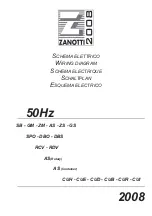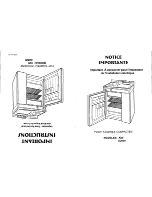
12
13
1
•
888
•
557
•
3848
Wards.com
Care & Maintenance (
cont’d
)
Moving your appliance:
• Remove all of the food.
• Securely tape down all loose items inside your appliance.
• Turn the leveling screws up to the base to avoid damage.
• Tape the doors shut.
• Be sure the appliance stays in the upright position during transportation.
Cleaning your appliance:
• Turn the temperature control to “0”, unplug the appliance and remove the food,
shelves and trays.
• Wash the inside with warm water and baking soda solution. The solution should
be about 2 tablespoons of baking soda to a quart of water.
• Wash the shelves and trays with a mild detergent solution. Plastic parts
CANNOT be washed in a dishwasher.
• The outside of the appliance should be cleaned with mild detergent and warm
water.
• The condenser coils should be vacuumed when they are dusty or dirty.
• Clean the drain pan on the refrigerator compressor. Do NOT remove the drain
pan.
• After cleaning, connect the appliance to the power supply and reload with trays,
shelves and food.
• The appliance should be located in the coolest area of the room, away from heat
producing appliances or heating ducts, and out of direct sunlight.
• Let hot foods cool to room temperature before placing in the appliance.
• Overloading the appliance forces the compressor to run longer. Foods that
freeze too slowly may lose quality or spoil.
• Be sure to wrap foods properly, and wipe containers dry before placing them in
the appliance. This will help reduce frost buildup inside the appliance.
• The storage drawers should not be lined with aluminum foil, wax paper or paper
towel. Liners interfere with cold air circulation, making the appliance less
efficient.
• Organize and label food to reduce door openings and extended searches.
Remove as many items as needed at one time and close the door as soon as
possible.
• Try not to open the door too often, especially when the weather is wet and hot.
• Every so often, check if the appliance is sufficiently ventilated.
• Ice and frost layer increase energy consumption, so clean the appliance as soon
as the layer is 1/4" thick.
Energy Saving Tips
Troubleshooting
You can solve many common appliance problems easily, saving you the cost of a
possible service call. Try the suggestions below to see if you can solve the problem
before calling a technician.
PROBLEM
POSSIBLE CAUSE(S)
Appliance does not operate.
Not plugged in.
The circuit breaker is tripped or blown fuse.
Appliance does not cool.
The appliance temperature control is set at “0”.
Compressor turns on and off frequently.
Condenser coil at the back of the unit is dirty.
The room temperature is hotter than normal.
A large amount of food has been placed in the
unit.
The door is opened too often.
The door is not closed completely.
The temperature control is not set correctly.
The door gasket does not seal properly.
The appliance does not have the correct
clearances (5" on each side and back of unit)
The light does not work.
The home circuit breaker or fuse has tripped.
The appliance is unplugged.
The bulb has burned out (see p. 11 for the
replacement procedure).
Vibrations
Check to ensure that the appliance is level.
The appliance seems to make too much
noise.
The rattling noise may come from the flow of the
refrigerant, which is normal.
As each cycle ends, you may hear gurgling
sounds caused by the flow of refrigerant.
Contraction and expansion of the inside walls
may cause popping and crackling noises.
The appliance is not level.
The door will not close properly.
The appliance is not level.
The doors were reversed and not properly
installed.
The gasket is dirty.
The shelves, bins or baskets are out of position.


























